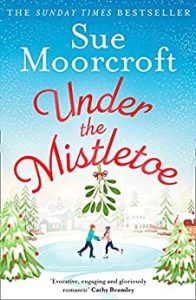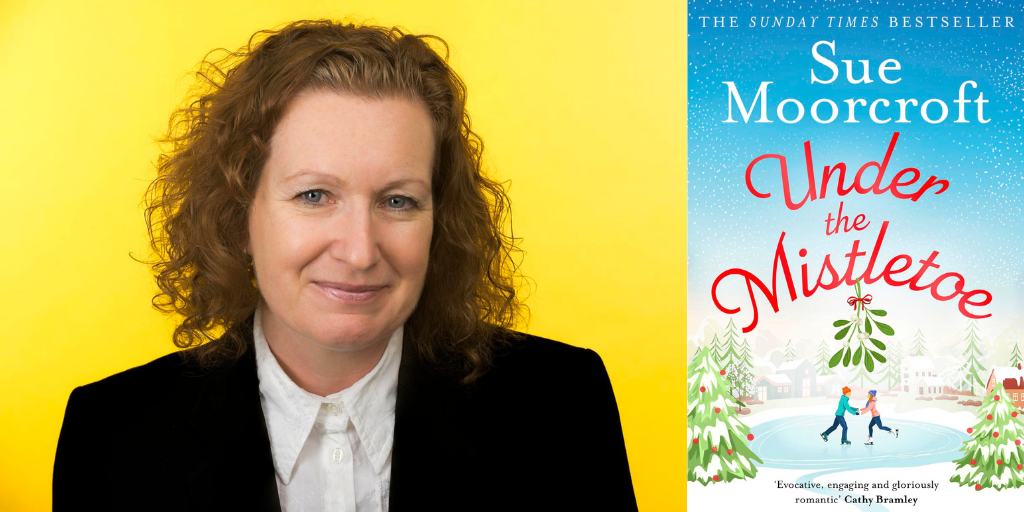‘Walking The Dragon’ An Interview With Sue Moorcroft
By Diya Padiyar
In these times of the pandemic, my writing allows me to do something that I cannot do otherwise: ‘travel’ the world, connecting with inspiring people from the comfort of my own home. Write On! has been a big part of this; the magazine and writing platform making it possible for me to connect with some awe-inspiring writers. Today is extra special, as I’ve been zooming with Sunday Times bestseller, Sue Moorcroft.
inspiring people from the comfort of my own home. Write On! has been a big part of this; the magazine and writing platform making it possible for me to connect with some awe-inspiring writers. Today is extra special, as I’ve been zooming with Sunday Times bestseller, Sue Moorcroft.
I’d read some of her work previously and it has always left me with the feeling of being hugged. I’m therefore pleased to report that her latest Christmas release, Under The Mistletoe, delivers that same warm glow.
Sue is currently editing her 20th novel and we start off by chatting about this, as well the poise and pensiveness in her writing, which I feel adds an important dimension. I also manage to get in pretty early on how precious it is for young, aspiring writers like me to hear about her journey through the writing school of hard knocks.
Sue shares how important a relationship with her readers is to her, through her books, of course, but also more generally. She tells me she always makes a point of responding to people who write to her on social media. “I’m a public face, so it’s a pleasure and privilege.”
Relationships are, of course, essential to any good story, and she tells me about how, at the tender age of nine, the literary one between Jean and Joe in Neville Shute’s A Town Like Alice inspired her to be “the person who puts words between the covers.”
Initially, this ambition was frustrated. First, by a detour to secretarial college and then, young motherhood. However, when her two children started school, she decided to revisit her literary ambitions. It’s been a bit of a rollercoaster ride, though: taking 20 years from her first published short story to getting to #1 on Kindle!
She’s keen to impress upon me that her goal – to make enough money from just being a novelist – has never changed (i.e. not depending on her other side-lines such as writing columns, teaching, judging competitions, to supplement her income). Though Sue shares that, despite having achieved this, she never stops trying to become a better version of herself. “Now that I’m a bestseller, I want to be the top bestseller, like Joanna Trollope, for example.”
A great example of this questioning and adapting, which has always kept her on track, comes from when she was infected with Covid. It turns out that, in this difficult time, she wasn’t just worried about her health. As a former magazine journalist, not being able to hit her deadlines frightened her almost more! At the time, she dealt with this by delaying the launch date but shares she’s also taken something important from that experience. “Since having Covid, I’ve been determined to protect myself a bit more and stay in the novel.“ She chuckles wryly, remembering back to when an editor told her that she must be the world’s most punctual author. “Focusing on my book deadlines has definitely made that easier.”
We move on to chat about evolving styles and bad habits. Sue shares how being given the chance to rewrite an early novel, Uphill All The Way, and seeing it republished as A Home In The Sun earlier this year, has given her the chance to experience how her writing has evolved:
“I seemed to be particularly fond of passive sentences and dotting around when I should have been setting the scene!”
We move on to talk about how Sue makes her world come alive to readers. For her, research is key: “I want my books to be authentic. It’s never certain the conflicts you’ve planned on will work, but good background work always shines through and can often lead to a new direction.”
Her retired brother helps her with this, working with another writer, Sue’s niece Nicki Moore, with her research work, too. Sue also spends time chatting to people who might help; artist Laurel’s experience was, for example, supported by an artist friend.
We talk about planning, or not, as the case may be: “At first I was a complete pantser, but I don’t think it’s a coincidence that the first book I planned was the one that got published.”
Sue goes on to share that over the years she’s come to trust her “plotting head” – letting it go and assuming it will be OK. She starts with scruffy handwritten notes, building on her characters, and then moves to the back story. “There is a moment when I’m working on the goals and conflicts when I know it is time to start… and I don’t always know the end, other than that they’re going to live happily ever after.” For Sue, the process of getting them there has never been through a chapter-by-chapter breakdown; rather, she believes in allowing enough room “to take the dragon for a walk”.
When asked about how she does this, Sue shares that her writing routine is critical in giving her the structured freedom she needs. However, due to moving offices, this week has been completely messed up. “Worth it, though!” She gestures around her new creative epicentre.
Sue’s day starts early, around six am, with a shower. She then heads straight to the computer to finish her day’s tasks: currently, it’s editing the novel she is working on. After a lunch of a bowl of porridge or a cereal bar, she goes for a walk, then more writing and, finally, any scheduled events in the evening. As Under The Mistletoe has just been released, she has three other interviews this week.
Before we move on to her creative style and the motivation behind it, we share our joy of dancing as a form of exercise and relaxation. Sue enjoys Zumba, and I tell her about Bharatanatyam, an Indian classical dance form that I initially started as exercise, but now enjoy for its own sake.
Sue kicks this part of the conversation off by telling me that despite being ‘popular fiction’ her books are about more than tinsel. “Strong, difficult themes go well with Christmas. Good and bad things happen, and in the festive season, bad things can often feel worse.”
As well as enabling great stories, along with one summer read per year, Christmas books also satisfy her publisher. Sue tells me how these commercial demands have the added benefit of sharpening her focus. The summer novels, for example, allow her to explore characters choosing to step away from their usual lives.
Write On! is currently exploring the theme Writing With Wonder: The World As Seen Through Children’s Eyes. In Under The Mistletoe, Sue’s character Daisy is confronted with a host of typical teen issues. As a teenager myself, I’m intrigued to find out how Sue gets into our minds. She tells me that, other than using social media to ask key questions, she also takes up residence in McDonald’s to listen to young people interact. I giggle with rueful recognition when she tells me: “If you’re over 40, teens seem to think they can’t be heard!”
Many of Sue’s books. including Under The Mistletoe, are set in the fictional village of Middledip. Coming from Goa, I find the Englishness of the setting and characters fascinating. I ask the question around the marketability of something so ‘quintessentially English’. Sue’s take is interesting: “How well my books do in other territories is very dependent on how closely aligned that culture is with the UK.”
She goes on to share that her books sell well in Germany, Italy and Bulgaria; do OK in Canada, but, interestingly, although they get into the top 100, are not as far-reaching in the US. We touch again on her restlessness and her need to always do better, sell more. International rights are a perfect case in point and Sue is keen to reach ever more markets, since, on the whole, international sales rights means extra money and no more work.
As we start winding up our time together, we both acknowledge the interview wouldn’t be complete without some writerly advice. So, Sue adds these very pertinent points:
- Be prepared to persist. The first novel that got accepted was my eighth and my first short story to get published was my 30th!
- Use newsletters and Arts Council websites to find courses and conferences. Use them to educate yourself. Although many are free, if they’re not, see it as a financial investment. It’s the way of the world!
- Sign up to The Bookseller daily emails. You get two free articles and can also find competitions to enter.
- Read everything you can and research, research, research!
We end with a quote from an Under The Mistletoe review, citing that Sue writes like a dream. She shares that this is maybe because she feels she is living the dream. Although, she caveats this by making sure I understand the price of success.
“I’ve had to work harder than I ever expected to. But when I hear people moaning about publishing contracts and the issues they face, I realise how lucky I am.”
Learning how Sue has kept going despite the odds, makes me even more determined to make my writing dream come true… assuming, of course, that Indian dragons are the same as English ones!
*****
Connect with Sue through her website: www.suemoorcroft.com on Twitter: @SueMoorcroft and on Instagram: @suemoorcroftauthor
Find Diya on Instagram: @teenagerwritings
 *****
*****
Sue has also generously sponsored a competition for Write On! readers and writers. The five runners up get their very own copy of Under The Mistletoe and the winner receives a signed one! All you need to do is pen 100 words in response to an image we have shared that reflects our ‘Writing With Wonder’ theme. To enter, visit our competitions page: pentoprint.org/get-involved/competitions/
*****
Issue 10 Write On! magazine is available now. You can find it here.
I want my books to be authentic. It’s never certain the conflicts you’ve planned on will work, but good background work always shines through and can often lead to a new direction.




